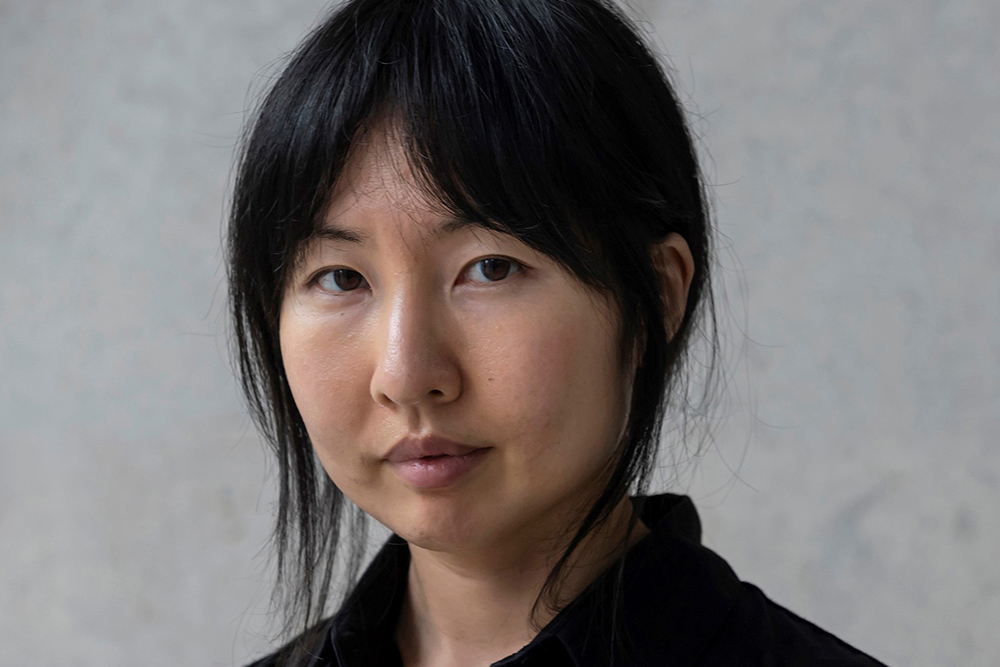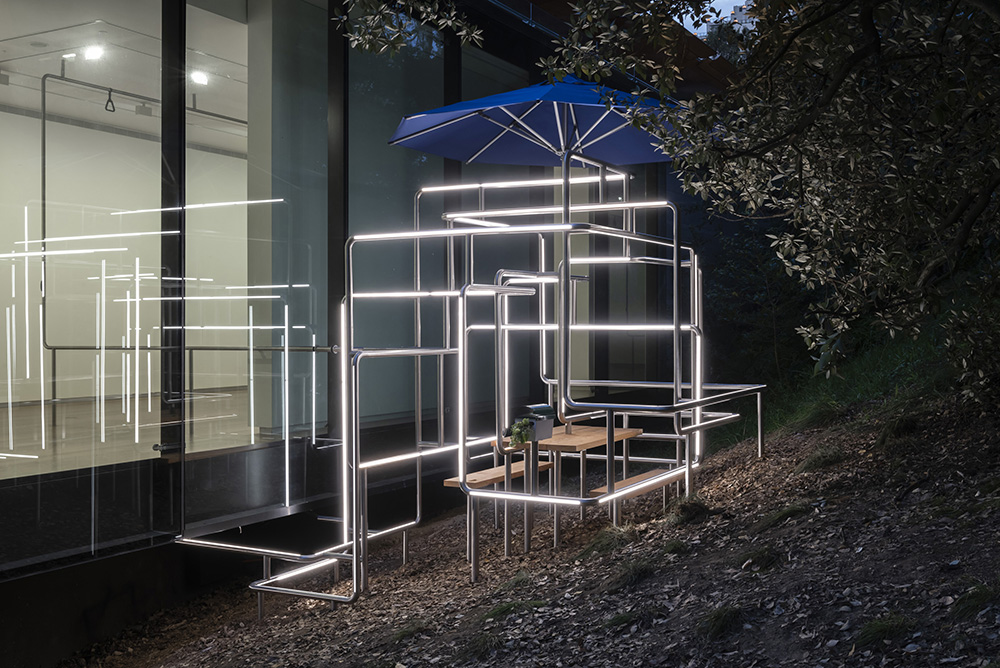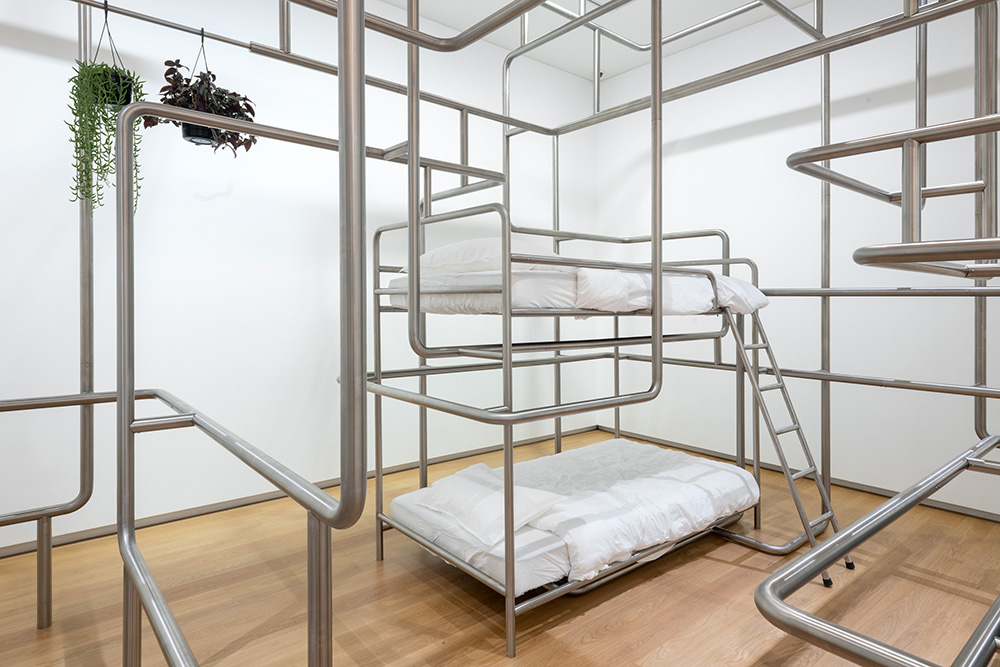
The inspiration for 5 Rooms came from the subway network Yona became acquainted with during her 2016 Foundation residency in Seoul
Can you briefly describe your work An Arrangement for 5 Rooms?
An Arrangement for 5 Rooms consists of stainless steel tubes attached with various urban and domestic objects such as lamps, bunk beds, a bar table, chairs, a bus handle and benches.
The work extends from the existing handrails at the Gallery to create elaborate linear structures that connect the 5 rooms in Friedlander space and beyond Albert park, stairways and the Pilaster area.
It invites viewers to rest, socialise and simply spend time within the work and can be experienced from both inside and outside the gallery, during both the day and the night.
How did the work evolve – what inspired it?
The work evolved from a conversation with the curator Natasha Conland, and what inspired me was the architectural layout within the Friedlander space and its relationship with Albert Park.
The layout of the five rooms in the space, with one room being after another in a linear way, reminded me of how one experiences listening to a piece of music.
I thought about the duration of the experience of the work as one walks through the five rooms and its relationship to the structure of a musical composition - where the structure of a musical piece consists of an introduction, a verse and a chorus and repeats itself with subtle variations.
When we listen to a piece of music, we experience moments of silence as intense as the moments with a lot going on with fast rhythm and loud sound. The rhythm became so essential in this work - extending beyond its role as a basic term in music, to also refer to the rhythm of the architecture, the circadian rhythm of our body and nature.
How did your time at the SeMa Nanji residency influence the work?
The ‘In Transit’ series of work began during my time at the SeMA Nanji residency in 2016. I was inspired by the infrastructure of the subway trains in Seoul, which made me meditate on how we move through spaces and the impact technology has had, particularly on our perception of time and space.
I was fascinated by the industrial area in Seoul called Euljiro where thousands of tiny shops sell everything you can think of. This abundant accessibility to materials allowed me to build knowledge and an understanding of materiality and objects that surround us, which has fed into my work.

The work extends out of the gallery (Photos courtesy of Fine Arts, Sydney, photograph by Jennifer French and Paul Chapman.)
Do you still keep in touch with arts practitioners you met in Seoul?
I still keep in touch with some of the artists and curators I met during the residency. We are mostly connected on social media; however, when I visit Seoul we catch up over a drink and dinner.
A special occasion was back in 2020, when I was invited to participate in the Busan Biennale, Yong Ju Kwon, an artist I met during the residency was also invited and we happened to show in the same space.
It’s really interesting to hear how the artists based in Korea operate and seeing a glimpse of the art scene through them.
What can you tell us about the ‘art scene’ in Seoul? What makes it unique?
I don’t think I know enough to say what the art scene in Korea is like, but I could tell there are a lot more artists working in Korea and a lot more kinds of spaces - they are big on private museums, which I think would be the most distinctive aspect in comparison to New Zealand.
I think the art schools in Korea practice a medium (cultural) specific degrees - for instance, you can specialise in Oriental painting or Western painting so you see a strong group of traditional Korean painting practices arise from it.
In saying that, there is also a tendency for Korean artists to go overseas to take post graduates studies in Europe and the United States, so you see various influences in their works due to this merging in a very interesting way.
There are also a number of good residencies, including the SeMa Nanji residency, that are open to local artists, which give a unique texture to the art scene in Korea.

Yona Lee's In Transit series was inspired by her time at SeMaNanji residency in Seoul, South Korea (Photos courtesy of Fine Arts, Sydney, photograph by Jennifer French and Paul Chapman.)
Why do you think it’s important/useful for New Zealand artists to do overseas residencies?
I think just being exposed to different art scenes and communities broadens your view on art in general and expands your perspective in your own art practice.
The overseas residencies offer opportunities; however, at the same time they restrict you as to how you would normally work, so it encourages you to try new things.
What are you up to at the moment?
I’m currently in Maastricht - doing a residency here at Jan Van Eyck. I’ve just arrived here two weeks ago and will stay here till the end of September.
It’s strange to travel but things are starting to open up - I didn’t need to have a negative test to catch the flights! And in the Netherlands things seem quite normal: no masks, no restrictions (if you get COVID you just isolate a few days until you return a negative test).


